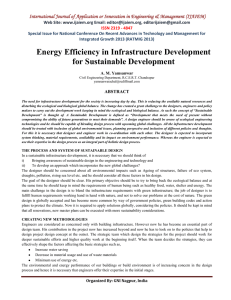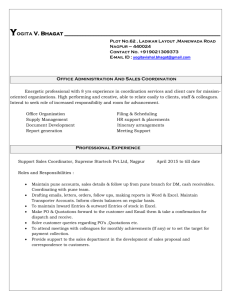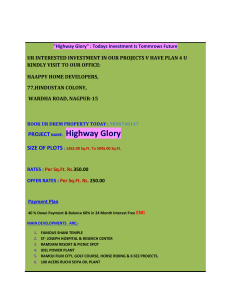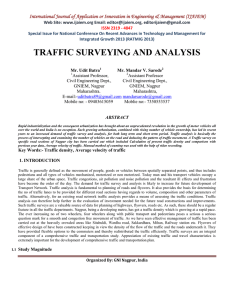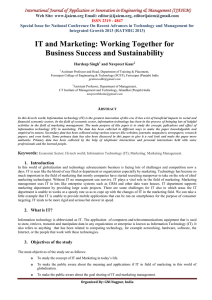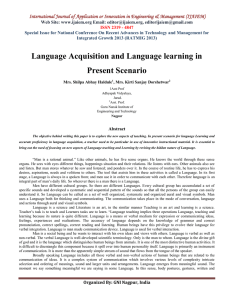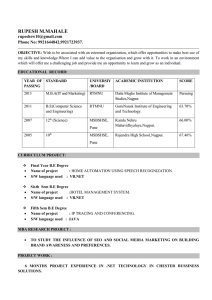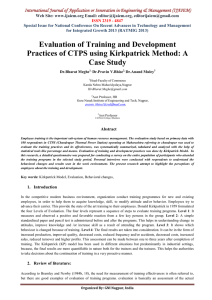International Journal of Application or Innovation in Engineering & Management...
advertisement
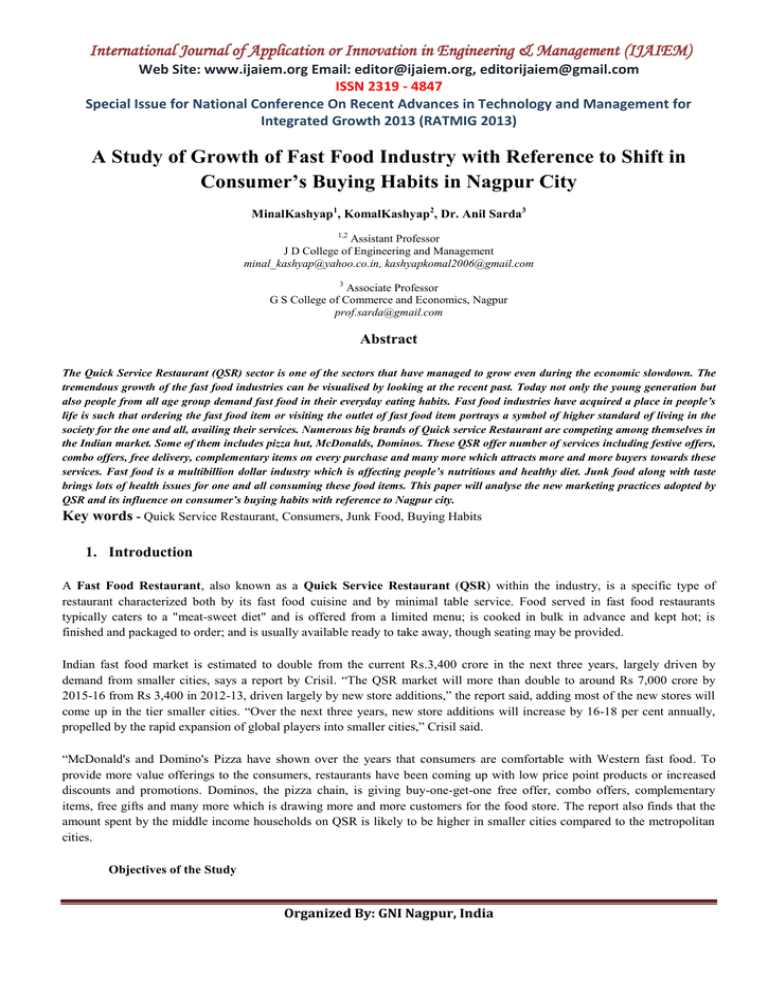
International Journal of Application or Innovation in Engineering & Management (IJAIEM) Web Site: www.ijaiem.org Email: editor@ijaiem.org, editorijaiem@gmail.com ISSN 2319 - 4847 Special Issue for National Conference On Recent Advances in Technology and Management for Integrated Growth 2013 (RATMIG 2013) A Study of Growth of Fast Food Industry with Reference to Shift in Consumer’s Buying Habits in Nagpur City MinalKashyap1, KomalKashyap2, Dr. Anil Sarda3 1,2 Assistant Professor J D College of Engineering and Management minal_kashyap@yahoo.co.in, kashyapkomal2006@gmail.com 3 Associate Professor G S College of Commerce and Economics, Nagpur prof.sarda@gmail.com Abstract The Quick Service Restaurant (QSR) sector is one of the sectors that have managed to grow even during the economic slowdown. The tremendous growth of the fast food industries can be visualised by looking at the recent past. Today not only the young generation but also people from all age group demand fast food in their everyday eating habits. Fast food industries have acquired a place in people’s life is such that ordering the fast food item or visiting the outlet of fast food item portrays a symbol of higher standard of living in the society for the one and all, availing their services. Numerous big brands of Quick service Restaurant are competing among themselves in the Indian market. Some of them includes pizza hut, McDonalds, Dominos. These QSR offer number of services including festive offers, combo offers, free delivery, complementary items on every purchase and many more which attracts more and more buyers towards these services. Fast food is a multibillion dollar industry which is affecting people’s nutritious and healthy diet. Junk food along with taste brings lots of health issues for one and all consuming these food items. This paper will analyse the new marketing practices adopted by QSR and its influence on consumer’s buying habits with reference to Nagpur city. Key words - Quick Service Restaurant, Consumers, Junk Food, Buying Habits 1. Introduction A Fast Food Restaurant, also known as a Quick Service Restaurant (QSR) within the industry, is a specific type of restaurant characterized both by its fast food cuisine and by minimal table service. Food served in fast food restaurants typically caters to a "meat-sweet diet" and is offered from a limited menu; is cooked in bulk in advance and kept hot; is finished and packaged to order; and is usually available ready to take away, though seating may be provided. Indian fast food market is estimated to double from the current Rs.3,400 crore in the next three years, largely driven by demand from smaller cities, says a report by Crisil. “The QSR market will more than double to around Rs 7,000 crore by 2015-16 from Rs 3,400 in 2012-13, driven largely by new store additions,” the report said, adding most of the new stores will come up in the tier smaller cities. “Over the next three years, new store additions will increase by 16-18 per cent annually, propelled by the rapid expansion of global players into smaller cities,” Crisil said. “McDonald's and Domino's Pizza have shown over the years that consumers are comfortable with Western fast food. To provide more value offerings to the consumers, restaurants have been coming up with low price point products or increased discounts and promotions. Dominos, the pizza chain, is giving buy-one-get-one free offer, combo offers, complementary items, free gifts and many more which is drawing more and more customers for the food store. The report also finds that the amount spent by the middle income households on QSR is likely to be higher in smaller cities compared to the metropolitan cities. Objectives of the Study Organized By: GNI Nagpur, India International Journal of Application or Innovation in Engineering & Management (IJAIEM) Web Site: www.ijaiem.org Email: editor@ijaiem.org, editorijaiem@gmail.com ISSN 2319 - 4847 Special Issue for National Conference On Recent Advances in Technology and Management for Integrated Growth 2013 (RATMIG 2013) 1. 2. 3. To evaluate the major growth drivers of fast food services in the market. To study the demographic profile of consumers of fast food services. To study the buying behaviour of consumers towards fast food services. Review of Literature The fast food industry, originally conceived in Southern California during the 1940s, not only altered the eating habits of Americans, but also those in many other countries around the world, including Asian countries (Schlosser, 2001).Fast food chains had been, innovative and forceful at inviting customers out of their kitchens up to fast food centres. (Cullen, 1994)stated in his work, titled “Time, tastes and technology: the economic evolution of eating out” interpreted that the rising Americanization of eating out had tracked a culture of fast food and provided more importance to convenience and eating out behaviour due to such certain reasons, dramatic changes occurred in fast food consumption of Asian countries (Shetty, 2002).Structural changes in the demand for food in Asia have projected that Asian countries had been undergoing transformations in their economies supported by rapid urbanization and this trend would continue in the years to come (Huang and Howarth, 1996) 2. Research Design 2.1 Research Designs and Methods This study is basically an exploratory research to give an insight into the trends that has increased the fast food consumption. The research has been carried out in two stages. In stage I, literature review has been done to study variables impacting consumer’s food choice. In second stage, data were gathered by primary data collection method through personally administered questionnaires. An exploratory questionnaire has been designed on parameters concerning food choice and a consumer survey has been conducted to study the scope to which consumer demographics and consumer psychographics has an impact on fast food choice. 2.2 Hypothesis of the Study 1. There is a relation between the individual’s age and frequency of visiting the fast food outlets. 2. There is relation between the income and spending habits of an individual. 2.3 Sampling Technique The technique of sampling used in this study was non-probability convenience sampling method because it was a feasible alternative, due to the limitation of time, costs, and conveniences in order to find adequate respondents. 2.4 Data Analysis and Interpretation The questionnaire has been distributed to 30respondents; the information collected can be depicted by the following graphs and tables. Table 1: Distribution of Individual Respondents by Demographic Factors Respondents Particulars Number of Respondents Parameter Variables Total (30) Gender Male 14 46.66666667 Female 16 53.33333333 Total 30 100 Organized By: GNI Nagpur, India Percentage International Journal of Application or Innovation in Engineering & Management (IJAIEM) Web Site: www.ijaiem.org Email: editor@ijaiem.org, editorijaiem@gmail.com ISSN 2319 - 4847 Special Issue for National Conference On Recent Advances in Technology and Management for Integrated Growth 2013 (RATMIG 2013) Age Income Marital status 18-24 years 15 50 24-28years 7 23.33333333 28-32years 5 16.66666667 32 years and above 3 10 Total 30 100 1.5 to 2.5 14 46.66666667 2.5 to 3.5 6 20 3.5 to 4.5 6 20 4.5 and above 4 13.33333333 Total 30 100 Married 14 46.66666667 Unmarried 16 53.33333333 Total 30 100 Profile of Respondents- The above table provides the insights of the demographic profile of the respondents. The sample size chosen for the study was of 30 respondents which includes 14 males and 16 females. Major population of the sample lies in the income group of 1.5 to 2.5 lakhs and 50% of the sample belongs to the age group of 18-24 years. Frequency of visits to fast food outlets by the consumers Once in a Once in week Twice in a week Thrice in a week Once in 15days month 15 5 4 4 2 Frequency of visits to Fast Food Outlets 7% Once in week 13% twice in week thrice in aweek 50% 13% once in 15days 17% once in a month Figure 1: Frequency of visits to Fast Food Outlets Interpretation-The above pie chart explains that 50% of the people prefer to visits fast food outlets once in a week. Influential factors of consumer’s buying process Easy access Reasonable prices Fascination of eating out Changing Life style Taste and cultural impact Organized By: GNI Nagpur, India Home delivery system International Journal of Application or Innovation in Engineering & Management (IJAIEM) Web Site: www.ijaiem.org Email: editor@ijaiem.org, editorijaiem@gmail.com ISSN 2319 - 4847 Special Issue for National Conference On Recent Advances in Technology and Management for Integrated Growth 2013 (RATMIG 2013) 26 27 9 11 22 30 Influential factors Home delivery system Taste and cultural impact Changing Life style Facination of eating out Series1 Reasonable prices Easy access 0 5 10 15 20 25 30 Responses of Respondants Figure 2: Influential factors of consumer’s buying process Interpretation- It can be analysed from the bar chart that the home delivery system and reasonable prices of the fast food services majorly influences the consumer’s buying behaviour. Growth drivers of Fast Food Industry Attractive Promotions Branding and packaging Increase in disposable income Fascination of western culture Supply chain integrity 27 16 24 20 26 Growth drivers Supply chain integrity Facination of western culture Increase in disposable income Branding and packaging Series1 Attractive Promotions 0 5 10 15 20 25 30 Responses from Respondents Figure 3: Growth drivers of Fast Food Industry Interpretation-The bar chart explains that attractive promotions and supply chain integrity are the major growth drivers of the industry. Hypothesis Testing Test of significance for the relationship between the individual’s age and frequency of visiting the fast food outlets. Table 2: Co-relation between Ages and Frequency of Visits Organized By: GNI Nagpur, India International Journal of Application or Innovation in Engineering & Management (IJAIEM) Web Site: www.ijaiem.org Email: editor@ijaiem.org, editorijaiem@gmail.com ISSN 2319 - 4847 Special Issue for National Conference On Recent Advances in Technology and Management for Integrated Growth 2013 (RATMIG 2013) Variable-I Variable-II 15 15 7 5 5 4 3 4 0 2 Co-relation 0.961523948 Variable I = Ages, Variable II= Frequency of visits From the above table it is inferred that the co-relation between ages and frequency of visits is more than 50% i.e. 96% hence there is a high degree of co-relation lies between the two variables. Test of significance for the relationship between income and spending habits of an individual. Table 3: Relationship between Income and Spending Habits Variable-I Variable-II 14 18 6 9 6 8 4 5 Co-relation 0.99366911 Variable I = Income, Variable II= Spending Habits From the above table it is inferred that the high degree of co-relation (99%) lies between the variables, income and spending habits of people and hence the hypothesis is been proved. 3. Conclusion to the Study As per the study it is analysed that consumers in the today’s market are more fascinated to western culture and increase in the facilities offered by fast food services driving the growth of the industry. The frequency of visiting the fast food outlets relates with the ages of the consumers as well as the income affects the spending habits of an individual. Nagpur is the city having very little places of hang out and parties have become status symbol in today’s dynamic culture. Where as young adults having lesser amount of money in the form of their pocket money moves to the fast food outlets which is significantly boosting the market value of fast food industry. The second side of the coin is been surveyed and found out that fast food items damaging human health and may lead to obesity, excess fat and serious diseases. Respondents are of the opinion that the fast food industry should involve the practice of using the healthy and nutritious food items. 3.1 Suggestions to the Study Fast food restaurants should do more to improve the nutritional quality of kids' meals and regular menu items. The more will be the use of nutritional items in the food, the more it will enhance the goodwill of the industry as a contributor of health to the society. 3.2 Limitations of the Study Sample size limited to 30 respondents in the city of Nagpur and individual responses may be biased at times. Time and Resources constraints. Research is not been carried out for the extended period of time. Organized By: GNI Nagpur, India International Journal of Application or Innovation in Engineering & Management (IJAIEM) Web Site: www.ijaiem.org Email: editor@ijaiem.org, editorijaiem@gmail.com ISSN 2319 - 4847 Special Issue for National Conference On Recent Advances in Technology and Management for Integrated Growth 2013 (RATMIG 2013) References [1] Mr M Vijayabaskar, Dr Sundaram N. (2012), “A market Study on key determinants of ready to eat/ cook products with respect to tier-i cities in southern India, Indian Food Journal, Vol. 2, pp. 168 - 170] [2] Cullen, P. (1994), “Time, tastes and technology: the economic revolution of eating out”, British Food Journal, Vol. 96 No. 10, pp. 4-6.5] [3] Anand, R. (2011), “A study of determinants impacting consumers food choice with reference tothe fast food consumption in India” Society and Business Review, Vol. 6 No. 2, pp 176-187.2] [4] Keynote, Fast Food and Home –Delivery outlets Market Update 2013 [5] Goyal, A. and Singh, N.P. (2007), “Consumer perception about fast food in India: an exploratory Study”, British Food Journal, Vol. 109 No. 2, pp. 182- 187] [6] Vanniarajan. T. (2009) “A tool for measuring Service Quality in Restaurants” Journal of Marketing & Communications, 4:3, pp. 176- 178] [7] www.helpguide.org/life/fast-food-nutrition.htm [8] http://business.mapsofindia.com/food-industry/fast-food-chains [9] Article.economictimes.indiatimes.com/Indian-food-indian-startups, June 15, 2012 [10] Article.economictimes.indiatimes.com/ Small cities to drive fast-food market to Rs 7k Cr by FY 16:Crisil, PTI September 22, 2013 Author Ms. MinalKashyapreceived the degrees of Bachelor and Master in Management (Finance and HR), from RTM Nagpur University in the year 2008 and 2010 respectively. She has been awarded 6th position in Merit list of MBA Course 2008 – 2010 by RTM Nagpur University. She is pursuing PhD in Finance from RTM Nagpur University.She has an industrial experience of two years as a HR Manager & presently she is serving as an Assistant Professor at J D College of Engineering andManagement since last two years. Organized By: GNI Nagpur, India International Journal of Application or Innovation in Engineering & Management (IJAIEM) Web Site: www.ijaiem.org Email: editor@ijaiem.org, editorijaiem@gmail.com ISSN 2319 - 4847 Special Issue for National Conference On Recent Advances in Technology and Management for Integrated Growth 2013 (RATMIG 2013) Co-Author Ms. KomalKashyapis working as an Assistant Professor at Nagpur Institute of Technology (NIT), MBA Department, Nagpur, since 2009.Being an Approved RTM Nagpur University Faculty, She has5 years of experience, out of which, 4 years are in Academics. She has received MBA Degree in Financial Management and was awarded with Gold Medal by DMSR G.S.College of Commerce and Economics, Nagpur for being a Top scorer in MBA Program in the year 2009.She is pursuing PhD in Finance from RTM Nagpur University., Co-Author Dr Anil Sarda– Bcom, MCom , LLB, MPhil and Phd in Economics (1997). He has served as an Ex- memberofBoard of Studies at Pune and RTM Nagpur University for about 3 years. Presently he is working as an Associate Professor with G. S College of Commerce & Economics and total 14 Phd degrees has been awarded under his guidance. He has published several Research Papers in International Journals. Organized By: GNI Nagpur, India
